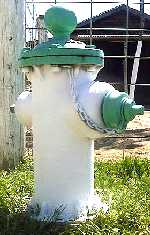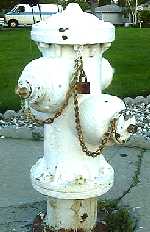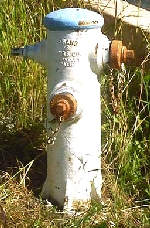© 2001 Capt. Willis Lamm, Water Supply Officer, Moraga-Orinda (CA) Fire District |
|
Please note: This anthology is based on our own best
knowledge and information gathered from this region. Verifiable corrections
and additions are welcome. Please contact the
Webmaster.
Many of the early water systems in America's cities were constructed from wooden pipes. These systems were under relatively low pressure. When a significant fire broke out, men would hastily dig out and expose the wooden water main and bore a hole to get access to the water inside. The excavation would fill with water and a hand pumper would draft from it. After the fire was over a wooden plug would be driven into the hole and hence the term "fire plug" originated. Volunteers would try to remember where all the plugs were located as it was faster to dig out and remove a plug than it was to bore a new hole. The earliest fire hydrants were wooden boxes which protected a pipe riser and valve. The wood provided some insulation, but in the coldest climates the risers would still freeze. The cast iron dry barrel fire hydrant was invented which would not freeze as the valve was located below the frost line which was operated by a nut on the top of the hydrant. |
Early cast iron hydrant
|
|
In 1851 a young foundry apprentice named Morris Greenburg, along with his family,
set out from France to for California in search of his fortune. Having arrived too late
to mine for gold, he saw a need for locally produced cast goods and founded
the Eagle Brass Foundry in San Francisco. His customers included the railroads,
maritime industry and he also produced castings for the growing municipality of San Francisco.
Greenburg was offered a contract to produce fire hydrants and he came up with an innovative "wet barrel" design which was faster and easier to operate and generally more reliable than current state-of-the-art dry barrel hydrants. Furthermore the wet barrel design allowed independent control of multiple hydrant outlets which improved the efficiency of fire fighters' water supply operations. Within a few years several California foundries were producing their own wet barrel hydrants. |
The ball on the top of
|
|
The wet barrel design was simple. The hydrant was cast like a piece of
pipe with flanges on the top and bottom. Pockets were cast on either
side of the barrel. The hydrant nozzle would be seated in lead in one
pocket and the valve stem guide was seated in lead on the opposite
pocket. The valve stems were sealed with graphite rope packing and the
valves could be serviced by unbolting the bonnet of the hydrant.
The valves would seat directly into the nozzles when closed, then retract sufficiently so as not to impede efficient flow when the hydrant was completely open. At this point in history lead was a common means of sealing valves and fittings and no one gave any thought to the cumulative affect that lead might have on drinking water quality. |
These early hydrants
|
|
As America geared up for World War II a number of military installations
were under construction. The wet barrel hydrants were a natural design
for use in temperate locations. Shand and Jurs of Berkeley designed an
improvement to the wet barrel design which eliminated the need for seating
nozzles and seats in lead. These hydrants had tapped and machined openings
where nozzles and stem guides could be screwed into the hydrant bodies
and seated against fiber gaskets.
This design improvement allowed for fast changing of nozzles without need for torches. If a nozzle was damaged or a different thread type or size was needed, the nozzle could be easily removed and replaced. Furthermore there was no longer any need for lead which reduced the risk of drinking water . Continue to Part 2 |
Shand & Jurs
|
Return to Water Supply Index
Back to Information Section
|
Unless otherwise noted, all contents of these WWW pages © 1996-2002, FireHydrant.org |



